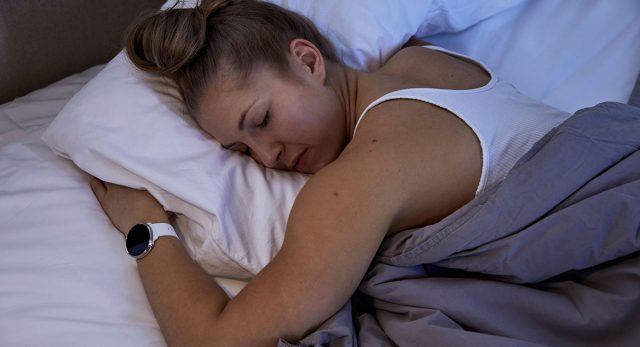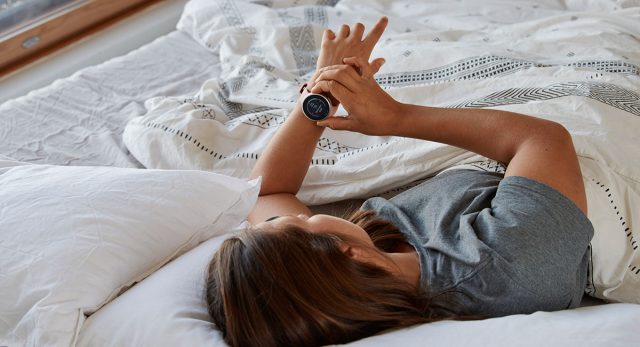This article is the second of a four-part blog post series, The Athlete Sleep Diaries, featuring real-life user experiences from four athletes who tracked their sleep and recovery with Polar Ignite fitness watch. In the articles, they share what they learned and how they used their sleep and recovery data to make changes. Read the first chapter, in which Les Mills Program Director Rachael Newsham shared how she took back control of her sleep and recovery after feeling tired all the time.
It’s no surprise sleep and athletic performance go hand-in-hand. It’s long been understood that a good night’s sleep leads to higher energy levels, more motivation, and the ability to prevent overuse injuries and sickness, but unfortunately it’s often the first thing sacrificed in order to get more done.
I was no stranger to this feeling as, like most of us, I was balancing a full plate of commitments and responsibilities with my two very different jobs as a legal advisor and a health coach.
Despite keeping a positive mindset and leading an active lifestyle, a few times a month, I would find myself feeling so exhausted that I wasn’t able to keep up with the everyday demands.
For me, Polar Ignite’s Nightly Recharge™ and Sleep Plus Stages™ features were (and continue to be) ideal tools to get to the bottom of my sleeping habits and recovery status. I used them to discover what I was doing (wrong) with regard to rest and recovery and what I should be doing instead.
Here’s how creating healthy sleep habits affected not only my productivity, but also my overall wellbeing.
I was exhausted without realizing it
I never thought that simply wearing a watch during the night could change my sleeping patterns so much.
Before using the Polar Ignite fitness watch, I was usually sleeping between five and six-and-a-half hours per night. I didn’t realize that I was actually exhausted because I was falling asleep the minute I laid my head on the pillow.
I thought I was sleeping enough and I wasn’t having any problems with waking up in the middle of the night. I never asked myself if I was feeling rested in the morning because I’m the kind of person who jumps out of bed immediately after hearing the first beat of that alarm. I’m always so excited to start my day, and sometimes I don’t notice things happening behind the scenes.
Of course, several times a month I became so tired that I’d have to postpone any activity scheduled in the morning, but I always blamed it on work, not on my sleeping habits. I was going to bed at around 11 p.m. (or even midnight) and my alarm was set for 6 a.m.
I was crushing all of my fitness goals, but I was feeling tired all the time.
When I was sleeping under eight hours a night, I was working out first thing in the morning right after waking up, so I usually didn’t feel tired. Around noon, though, the fatigue usually kicked in and I would need an extra boost of green tea or a little bit of chocolate.
Also, when it would get hot during the summer, I felt like I couldn’t rest at all. My training was bad, my heart rate was high even at night and I didn’t have a chance to rest properly.
After wearing the Polar Ignite, I realized I had some sleeping problems that needed to be addressed (and that was hard to admit).
POLAR SLEEP INFO: OPTIMAL AMOUNT OF SLEEP
Even though there isn’t one specific amount of sleep that is right for everyone, Flavia’s idea of opting for eight hours of sleep each and every night is a great starting point for most.
Although eight hours isn’t always enough – and sometimes even seven can be plenty) as sleep and the required amount of rest are very individual and varies according to training load, stress, the body’s condition and individual differences.
Polar user tip: If you’re a Polar Ignite user, you can set your preferred sleep time on your watch from Settings > Physical settings > Your preferred sleep time. Be sure to wear the wristband snuggly around the wrist in your non-dominant hand, and wear the device for at least 90 minutes before going to bed.
My sleep feedback Was less-than-ideal
The one thing that immediately struck me was the less-than-ideal feedback I was receiving from the watch. I usually got messages that said either COMPROMISED or even POOR, so I realized that something had to change.
As I mentioned already, the fact that I wasn’t waking up during the night had me under the impression that I was okay.
Also, the fact I’d consistently fall asleep instantly was another sign that confirmed my false idea that everything was under control.
I was wrong and I know that now, so after receiving such poor feedback from my Ignite, I implemented some changes.
POLAR SLEEP INFO: SLEEP STAGES
Flavia’s reaction to the feedback on her sleep patterns is something many users experience.
Not all sleep is created equal — even though you’re asleep, that doesn’t mean you’re efficiently recharging your batteries. This is where Polar’s Sleep Plus Stages™ feature is valuable.
Polar’s Sleep Plus Stages™ automatically tracks the amount and quality of your sleep and shows you how long you spent in each sleep stage. It gathers your sleep time and sleep quality components into one easily glanceable value, sleep score. Sleep score tells you how well you slept compared to the indicators of a good night’s sleep based on the current sleep science.
Your sleep time, in other words the duration between when you fell asleep and woke up, must be at least four hours to get Sleep Plus Stages™ metrics. You get sleep stages information (light sleep, deep sleep, REM sleep) and sleep score after one night, including feedback on themes (amount, solidity and regeneration).
Making Changes and Getting Results
The first thing I addressed was my sleeping hours.
I changed the desired sleep time to eight hours per night and started to go to bed a bit earlier — around 10:30 or 11 p.m. — but I slept in longer. The first thing that actually changed was that the dark circles under my eyes really started to fade.
Of course, I didn’t like all the changes because I was under the impression that I couldn’t crush my goals the same way I did when I was waking up earlier. But it was worth it when certain things changed after a few weeks of getting the recommended eight hours of sleep per night.
One thing that I noticed (and am so proud of) is that my heart rate is finally low during the night.
READ MORE:
The Doctor Prescribes: Sleep and Exercise
Another reason why I chose a target of eight hours of sleep was the fact that I was getting such a bad feedback from my Polar Ignite regarding my ANS charge. I was breathing heavily, and that didn’t help my goal of getting restful sleep. After hitting my eight hours a night, this was no longer an issue.
Speaking of restful sleep, it was interesting seeing what kind of sleep I had — whether it’s light, deep, REM and even interrupted. Also, the app gives a really easy-to-understand illustration that helped with improving all aspects of sleep, and I found the advice that’s given after syncing the watch with the app to be very insightful.
If you haven’t really slept well, the app actually encourages you to take a break, to try Serene™ breathing exercises, or even take the day off.
My training plans haven’t changed that much after using the Ignite, but I do admit that I try to keep my activity levels under control and I listen to all the advice that I get through the watch. Now, getting 100 percent on my activity level is just as important as getting the green light and the ‘very good’ feedback for my sleep patterns.
POLAR SLEEP INFO: ANS CHARGE
The ANS charge is one of the two components of the Nightly Recharge™ overnight recovery measurement.
The Nightly Recharge status shows you how well you recover from the demands of your day based on two components: how you slept (sleep charge) and how well your autonomic nervous system (ANS) calmed down during the early hours of your sleep (ANS charge).
Both components are formed by comparing your last night to your usual levels from the past 28 days. Your watch automatically measures both sleep charge and ANS charge during the night.
Breathing causes variation to the heart’s beat-to-beat intervals which can be measured optically from the wrist. When you are under stress your heart rate and breathing rate are higher than usual, and heart rate variability is lower than usual. Other factors that prevent efficient ANS recovery during sleep include hard physical exercise, intense emotions, alcohol, fever and inflammation.
Key Lessons Learned
As mentioned, I’ve seen several long-term benefits from using the Polar Ignite to track my sleep patterns.
The most important thing I’ve learned, though, is that sleep is actually a very important part of life and should be treated as a priority.
Even if you aren’t active daily, sleep is a powerful tool that can change the way you feel, eat, train and even interact with other people.
I now know eight hours of sleep is a must — no matter what your goal is.
Read More Athlete Sleep Diaries:
If you liked this post, don’t forget to share so that others can find it, too.
Or give it a thumbs up!
I like this article
Please note that the information provided in the Polar Blog articles cannot replace individual advice from health professionals. Please consult your physician before starting a new fitness program.





